The Influence of Noise Level on the Value of Uncertainty in a Measurement System Containing an Analog-to-Digital Converter
Abstract
1. Introduction
1.1. Motivations
1.2. State of the Art
1.3. Contributions
2. Materials and Methods
2.1. Measurement System for Evaluating Uncertainty of Measurement Modules
2.2. LabVIEW Application Controlling Measurements
- (a).
- Method of imposed values;
- (b).
- Method of effective number of degrees of freedom;
- (c).
- Method of geometric sum.
3. Experimental Results
3.1. Dependence of Measurement Uncertainty on the Length of the Measurement Series
3.2. Effect of Length of Averaged Measurement Series on Type-A Uncertainty
4. Discussion of the Obtained Results
5. Conclusions
Author Contributions
Funding
Data Availability Statement
Conflicts of Interest
References
- Wiczynski, G.; Kuwalek, P. Voltage Distortion Influence on Flicker Severity Measurement by AMI Energy Meters. IEEE Trans. Ind. Electron. 2021, 69, 10684–10693. [Google Scholar] [CrossRef]
- Wiczynski, G.; Kuwalek, P. Influence of Sampling Rate on Flicker Assessment by IEC Flickermeter Built-In AMI Energy Meters. IEEE Trans. Ind. Electron. 2021, 69, 9566–9574. [Google Scholar] [CrossRef]
- Kuwałek, P.; Wiczyński, G. Problem of Total Harmonic Distortion Measurement Performed by Smart Energy Meters. Meas. Sci. Rev. 2022, 22, 1–10. [Google Scholar] [CrossRef]
- Cipriani, G.; Miceli, R.; Spataro, C. Uncertainty evaluation in the measurements for the electric power quality analysis. In Proceedings of the 2013 International Conference on Renewable Energy Research and Applications, Madrid, Spain, 20–23 October 2013; pp. 1151–1156. [Google Scholar] [CrossRef]
- Lampasi, D.A.; Podesta, L. A Practical Approach to Evaluate the Measurement Uncertainty of Virtual Instruments. In Proceedings of the 21st IEEE Instrumentation and Measurement Technology Conference (IEEE Cat. No.04CH37510), Como, Italy, 18–20 May 2004; Volume 1, pp. 146–151. [Google Scholar]
- Bath, S.K.; Kumra, S. Simulation and Measurement of Power Waveform Distortions using LabVIEW. In Proceedings of the 2008 IEEE International Power Modulators and High-Voltage Conference, Las Vegas, NV, USA, 27–31 May 2008. [Google Scholar]
- Nuccio, S.; Spataro, C.; Tine, G. Virtual Instruments: Uncertainty Evaluation in the Presence of Electromagnetic Interferences. In Proceedings of the IEEE International Workshop on Advanced Methods for Uncertainty Estimation in Measurement, Sardagna, Italy, 16–18 July 2007; pp. 115–120. [Google Scholar]
- Arunshankar, V.K.; Kumar, N.S. Power Quality Monitoring and Control Using Virtual Instrumentation System. Power Res. J. CPRI 2014, 10, 119–124. [Google Scholar]
- Ghiani, E.; Locci, N.; Muscas, C. Auto-Evaluation of the Uncertainty in Virtual Instruments. IEEE Trans. Instrum. Meas. 2004, 53, 672–677. [Google Scholar] [CrossRef]
- Zang, C.; Wen, Y.; Wu, H. The application of the virtual instrument technology in high voltage measuring system. IEEE/PES Transm. Distrib. Conf. Exhib. 2002, 3, 2300–2304. [Google Scholar] [CrossRef]
- Dwivedi, V.; Singh, D. Electric Power Quality Monitoring (PQM) using Virtual Instrumentation. In Proceedings of the SPEEDAM 2010, Pisa, Italy, 14–16 June 2010; pp. 431–436. [Google Scholar] [CrossRef]
- JCGM 100:2008; Joint Committee for Guides in Metrology: Evaluation of Measurement Data—Guide to the Expression of Uncertainty in Measurement. BIPM Joint Committee for Guides in Metrology: Paris, France, 2008.
- JCGM 104:2009; Joint Committee for Guides in Metrology: Evaluation of Measurement Data—An introduction to the “Guide to the Expression of Uncertainty in Measurement” and Related Documents. BIPM Joint Committee for Guides in Metrology: Paris, France, 2009.
- JCGM 200:2012; Joint Committee for Guides in Metrology: International Vocabulary of Metrology—Basic and General Concepts and Associated Terms (VIM). BIPM Joint Committee for Guides in Metrology: Paris, France, 2012.
- EN 61000-4-8; Electromagnetic compatibility (EMC) Testing and measurement techniques. Power frequency magnetic field immunity test. International Electrotechnical Commission: Geneva, Switzerland, 2010.
- Otomański, P.; Pawłowski, E.; Szlachta, A. The Evaluation of Expanded Uncertainty of DC Voltages in the Presence of Electromagnetic Interferences using the LabVIEW Environment. Meas. Sci. Rev. 2021, 21, 136–141. [Google Scholar] [CrossRef]
- Sabat, W.; Klepacki, D.; Kamuda, K.; Kuryło, K. Analysis of LED Lamps’ Sensitivity to Surge Impulse. Electronics 2022, 11, 1140. [Google Scholar] [CrossRef]
- Pleština, V.; Boras, V.; Turić, H. The Measurement Uncertainty in Determining of Electrical Resistance Value by Applying Direct-Comparison Method. Energies 2022, 15, 2115. [Google Scholar] [CrossRef]
- Rath, M.F.; Schweighofer, B.; Wegleiter, H. Uncertainty Analysis of an Optoelectronic Strain Measurement System for Flywheel Rotors. Sensors 2021, 21, 8393. [Google Scholar] [CrossRef] [PubMed]
- National Instruments. USB-6001, Low-Cost DAQ USB Device, Specifications 374369A-01; National Instruments: Austin, TX, USA, 2014. [Google Scholar]
- National Instruments. USB-6008, 8 AI (12-Bit, 10 kS/s), 2 AO (150 Hz), 12 DIO USB Multifunction I/O Device, Specifications 375295C-01; National Instruments: Austin, TX, USA, 2017. [Google Scholar]
- National Instruments. USB-9215 Series, 4-Channel, ±10 VDC, 16-Bit Simultaneous Sampling Analog Input Devices, User Guide and specifications 371568E-01; National Instruments: Austin, TX, USA, 2007. [Google Scholar]
- National Instruments. USB-6341, 16 AI (16-Bit, 500 kS/s), 2 AO (900 kS/s), 24 DIO USB Multifunction I/O Device, Specifications 377879A-01; National Instruments: Austin, TX, USA, 2019. [Google Scholar]
- Zhang, J.; Xie, Y.; Huang, J.; Mo, C.; Mu, D.; Li, M. Design and simulation of reference voltage sources circuit in lasers. Microw. Opt. Technol. Lett. 2022, 1–6. [Google Scholar] [CrossRef]
- Texas Instruments. REF102, 10V Precision Voltage Reference, Data Sheet SBVS022B, Rev. 2009. Available online: https://www.ti.com/lit/ds/symlink/ref102.pdf?ts=1673877300040&ref_url=https%253A%252F%252Fwww.ti.com%252Fproduct%252FREF102 (accessed on 20 September 2022).
- Pawłowski, S.; Plewako, J. Applicability assessment for simplified formulas to compute surface impedance at screened surfaces. Przeglad Elektrotechniczny 2015, 12, 182–184. [Google Scholar] [CrossRef]
- National Instruments. LabVIEW User Manual, Number 320999E-01; National Instruments: Austin, TX, USA, 2003. [Google Scholar]
- Sokoloff, L. Applications in LabVIEW; Pearson Prentice Hall: Upper Sadle River, NJ, USA, 2004. [Google Scholar]
- National Instruments. LabVIEW Measurement Manual, Number 322661B-01; National Instruments: Austin, TX, USA, 2003. [Google Scholar]
- Otomański, P.; Szlachta, A. The Evaluation of Expanded Uncertainty of Measurement Results in Direct Measurements Using the LabVIEW Environment. Meas. Sci. Rev. 2008, 8, 147–150. [Google Scholar] [CrossRef]
- Otomański, P.; Krawiecki, Z.; Odon, A. The application of the LabVIEW environment to evaluate the accuracy of alternating voltage measurements. J. Physics: Conf. Ser. 2010, 238, 319–332. [Google Scholar] [CrossRef]
- Świsulski, D.; Pawłowski, E.; Dorozhovets, M. Digital Processing of Frequency–Pulse Signal in Measurement System. In Analysis and Simulation of Electrical and Computer Systems; Springer: Cham, Switzerland, 2018; pp. 319–332. [Google Scholar] [CrossRef]
- Pawlowski, E. Design and evaluation of a flow-to-frequency converter circuit with thermal feedback. Meas. Sci. Technol. 2017, 28, 054004–054013. [Google Scholar] [CrossRef]
- Dorozhovets, M. Effectiveness of Automatic Correction of Systematic Effects in Measuring Chains. Meas. Sci. Rev. 2019, 19, 132–143. [Google Scholar] [CrossRef]
- Warda, P. Simulation of an Adaptive Method of Improving the Accuracy and Extending the Range of Frequency Signal Processing in a Frequency-to-Code Converter. Appl. Sci. 2021, 11, 10341. [Google Scholar] [CrossRef]
- Turzeniecka, D. Errors in the evaluation of the coverage factor as a criterion of applications of approximate methods of evaluation of expanded uncertainty. Measurement 2000, 27, 223–229. [Google Scholar] [CrossRef]

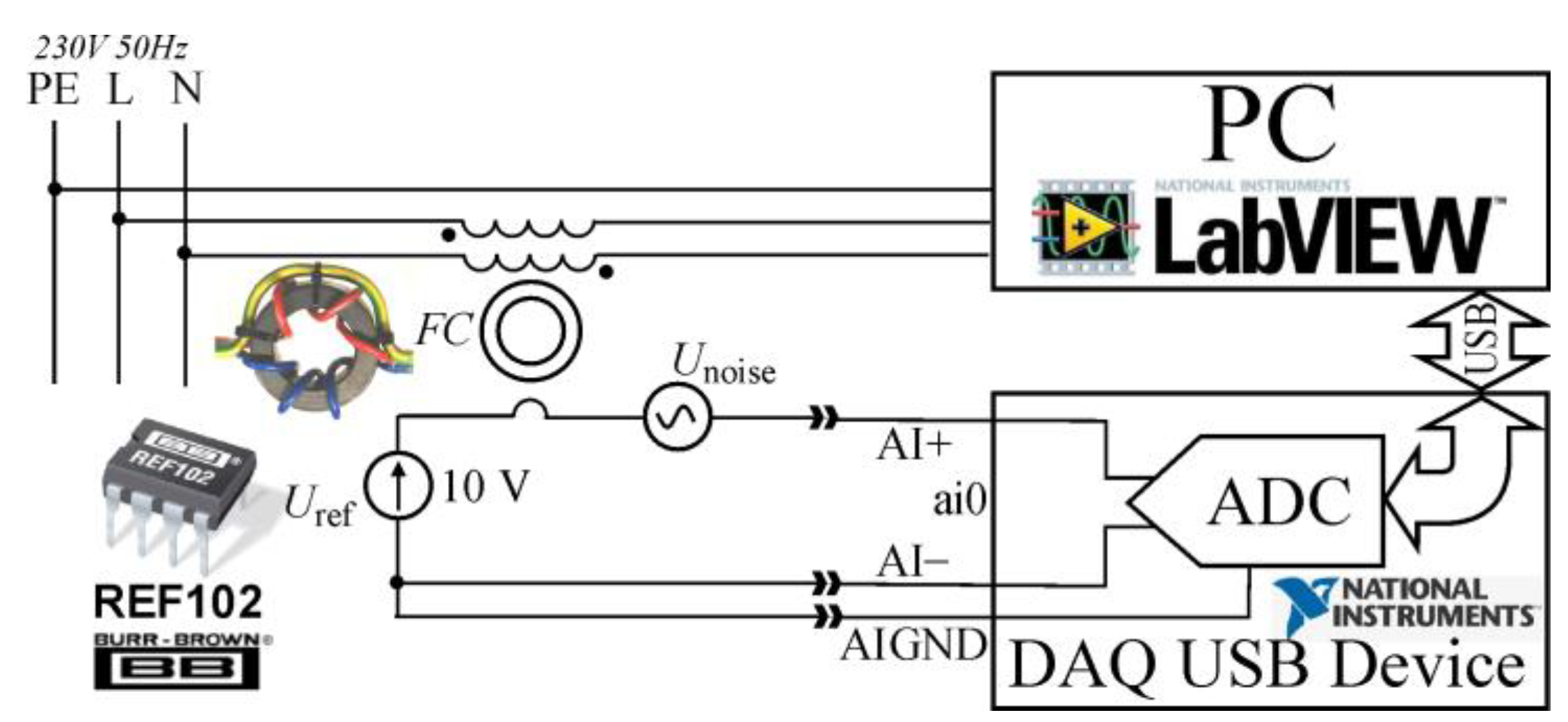
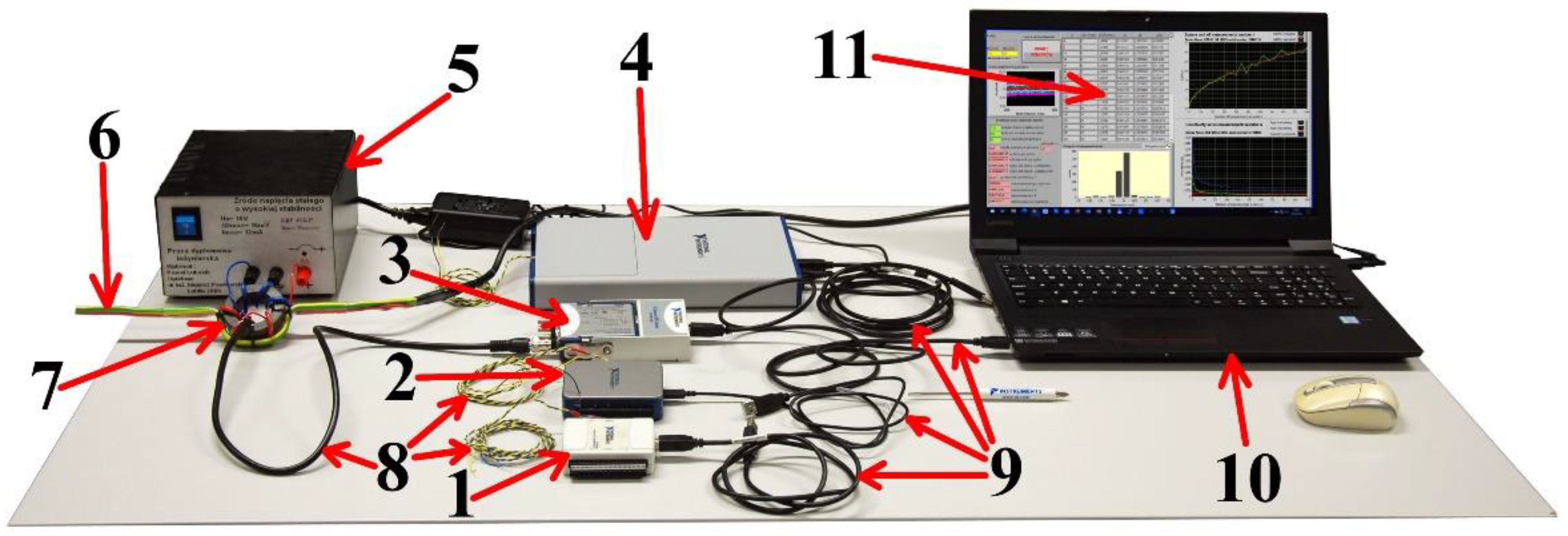

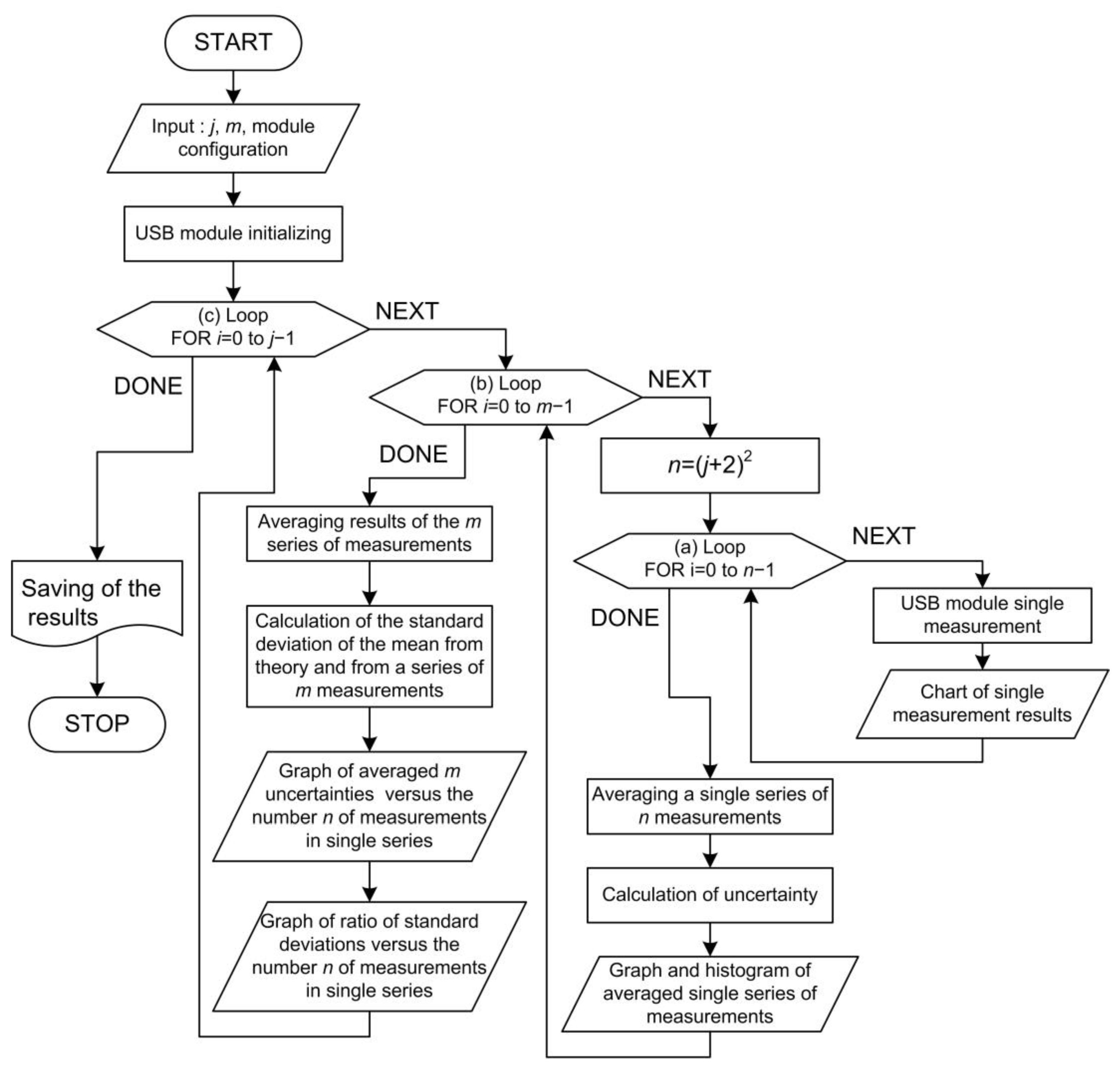
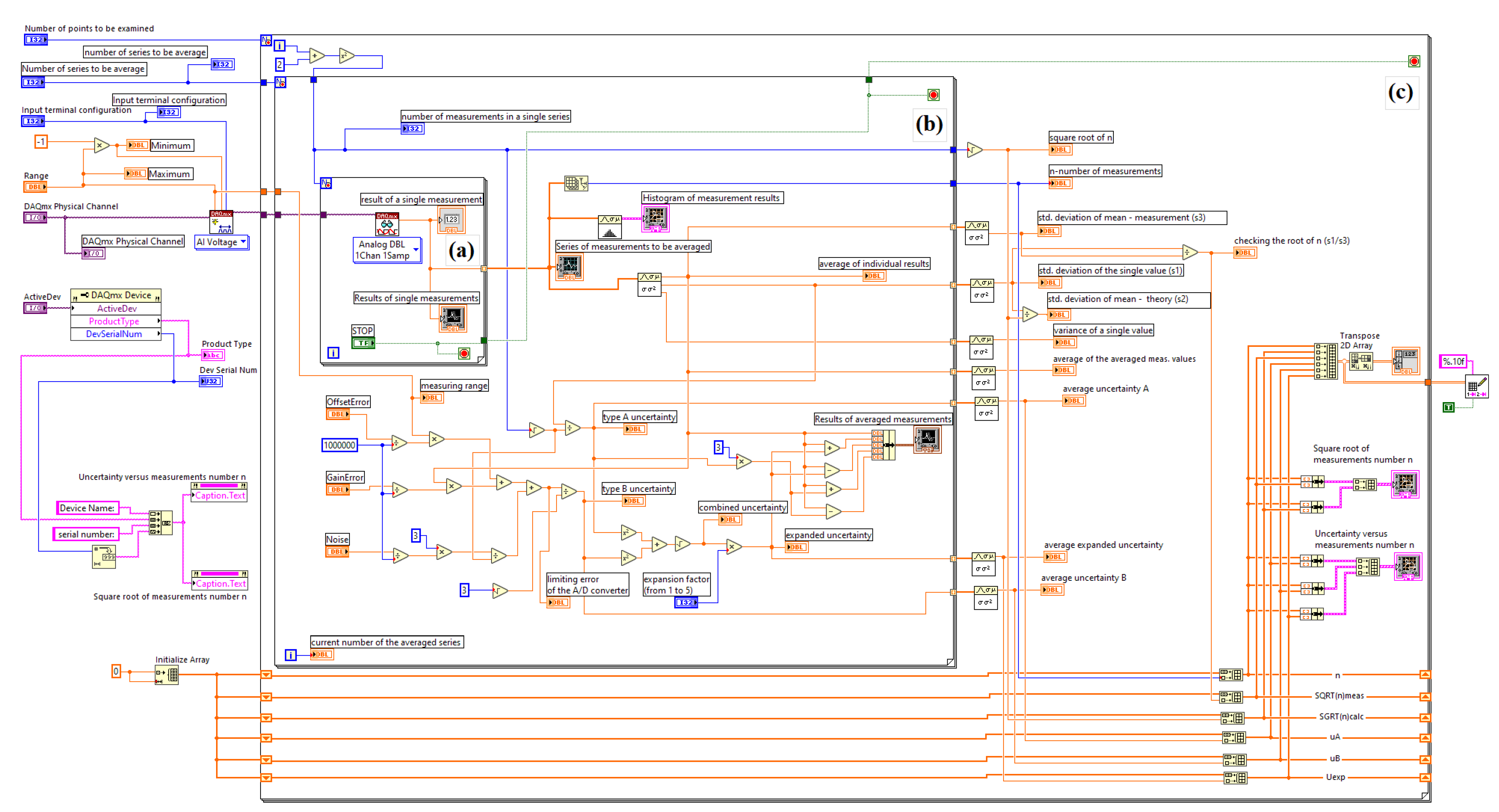

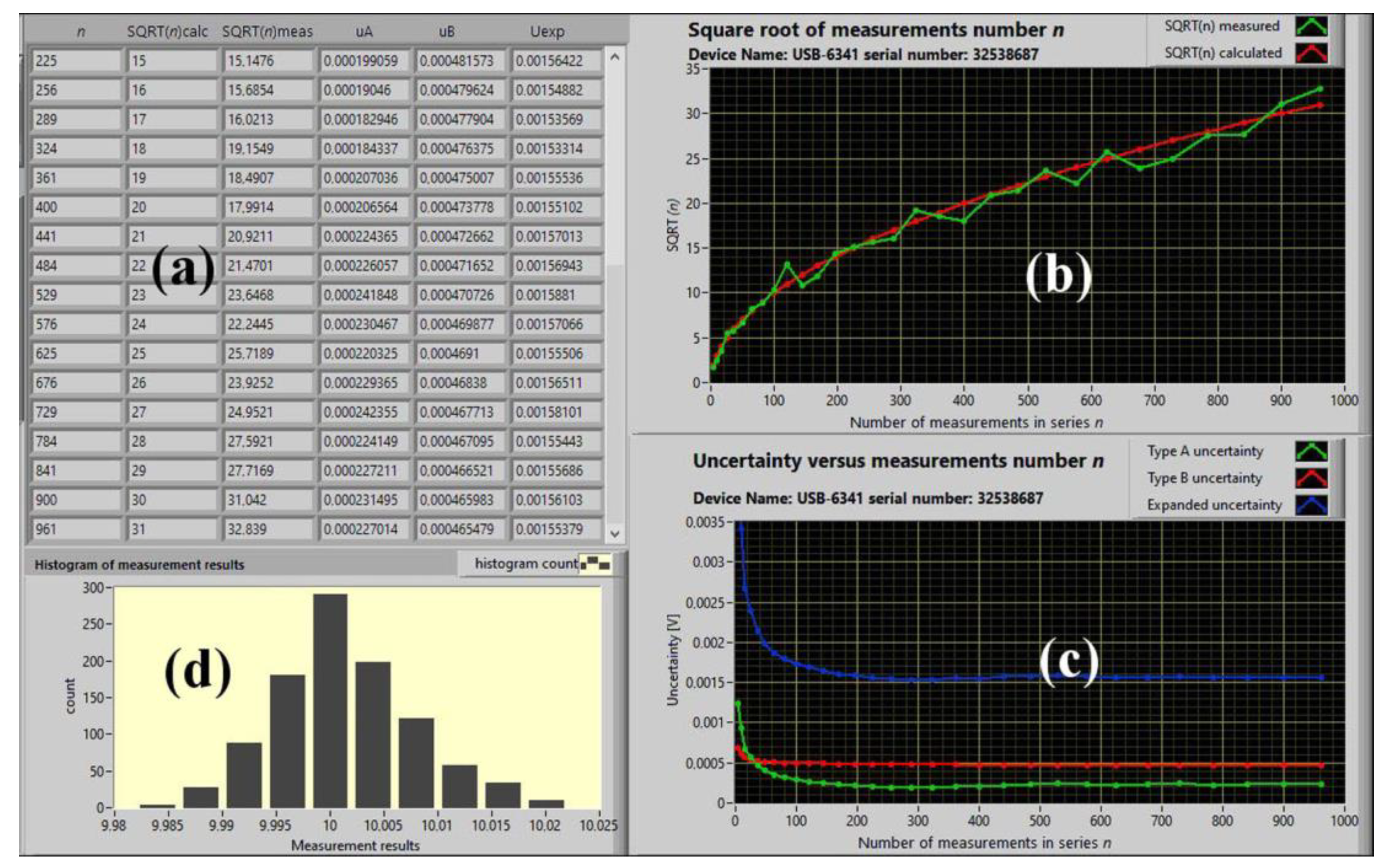












| Model | Resolution | Gain Error | Offset Error | Random Error | Limit Error |
|---|---|---|---|---|---|
| Bits | ppm of Reading | ppm of Range | μVrms | mV | |
| USB 6008 | 12 | – | 773 | 5000 | 7.73 |
| USB 6001 | 14 | – | 600 | 700 | 6 |
| USB 9215 | 16 | 200 | 140 | 184 | 4.535 |
| USB 6341 | 16 | 65 | 13 | 270 | 2.190 |
| Nominal Voltage | Maximum Error | Temperature Drift | Time Drift | Noise |
|---|---|---|---|---|
| 10 V | ±2.5 mV | ±2.5 ppm/°C | ±5 ppm/1000 h | 5 μVpp |
| Model | n | Low Level of Interference | High Level of Interference | ||||
|---|---|---|---|---|---|---|---|
| uA | uB | U | uA | uB | U | ||
| V | V | V | V | V | V | ||
| 4 | 0.00282 | 0.00446 | 0.0162 | 0.0610 | 0.0045 | 0.184 | |
| USB 6008 | 196 | 0.00048 | 0.00446 | 0.0135 | 0.0098 | 0.0045 | 0.032 |
| 1024 | 0.00013 | 0.00446 | 0.0134 | 0.0041 | 0.0045 | 0.018 | |
| 4 | 0.00146 | 0.00346 | 0.0114 | 0.0530 | 0.0035 | 0.159 | |
| USB 6001 | 196 | 0.00022 | 0.00346 | 0.0104 | 0.0098 | 0.0035 | 0.031 |
| 1024 | 0.00010 | 0.00346 | 0.0104 | 0.0041 | 0.0035 | 0.016 | |
| 4 | 0.00037 | 0.00212 | 0.0065 | 0.0660 | 0.0021 | 0.198 | |
| USB 9215 | 196 | 0.00006 | 0.00198 | 0.0060 | 0.0097 | 0.0020 | 0.030 |
| 1024 | 0.00003 | 0.00197 | 0.0059 | 0.0042 | 0.0020 | 0.014 | |
| 4 | 0.00091 | 0.00068 | 0.0035 | 0.0620 | 0.0007 | 0.186 | |
| USB 6341 | 196 | 0.00018 | 0.00048 | 0.0016 | 0.0096 | 0.0005 | 0.029 |
| 1024 | 0.00013 | 0.00047 | 0.0015 | 0.0043 | 0.0005 | 0.013 | |
Disclaimer/Publisher’s Note: The statements, opinions and data contained in all publications are solely those of the individual author(s) and contributor(s) and not of MDPI and/or the editor(s). MDPI and/or the editor(s) disclaim responsibility for any injury to people or property resulting from any ideas, methods, instructions or products referred to in the content. |
© 2023 by the authors. Licensee MDPI, Basel, Switzerland. This article is an open access article distributed under the terms and conditions of the Creative Commons Attribution (CC BY) license (https://creativecommons.org/licenses/by/4.0/).
Share and Cite
Pawłowski, E.; Szlachta, A.; Otomański, P. The Influence of Noise Level on the Value of Uncertainty in a Measurement System Containing an Analog-to-Digital Converter. Energies 2023, 16, 1060. https://doi.org/10.3390/en16031060
Pawłowski E, Szlachta A, Otomański P. The Influence of Noise Level on the Value of Uncertainty in a Measurement System Containing an Analog-to-Digital Converter. Energies. 2023; 16(3):1060. https://doi.org/10.3390/en16031060
Chicago/Turabian StylePawłowski, Eligiusz, Anna Szlachta, and Przemysław Otomański. 2023. "The Influence of Noise Level on the Value of Uncertainty in a Measurement System Containing an Analog-to-Digital Converter" Energies 16, no. 3: 1060. https://doi.org/10.3390/en16031060
APA StylePawłowski, E., Szlachta, A., & Otomański, P. (2023). The Influence of Noise Level on the Value of Uncertainty in a Measurement System Containing an Analog-to-Digital Converter. Energies, 16(3), 1060. https://doi.org/10.3390/en16031060








